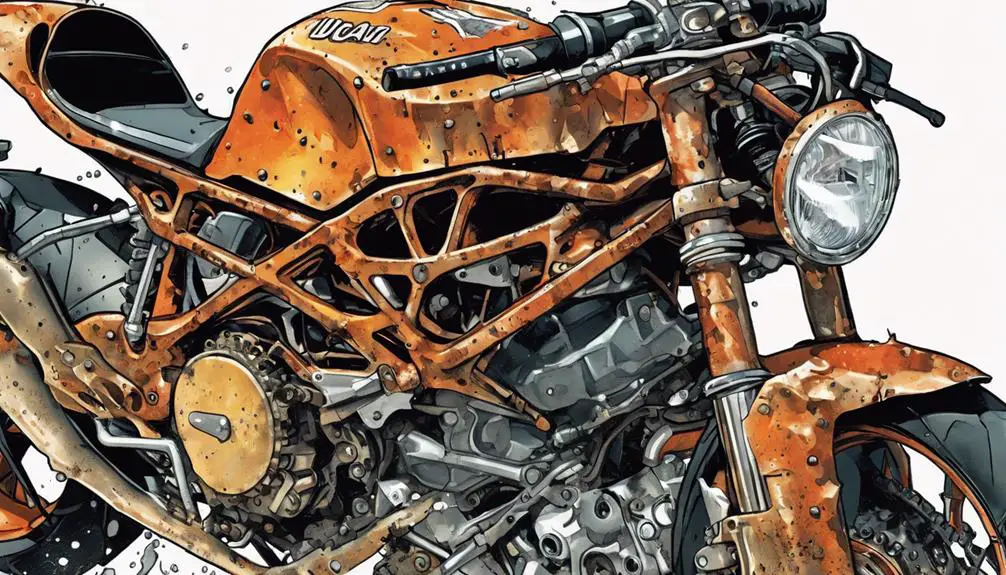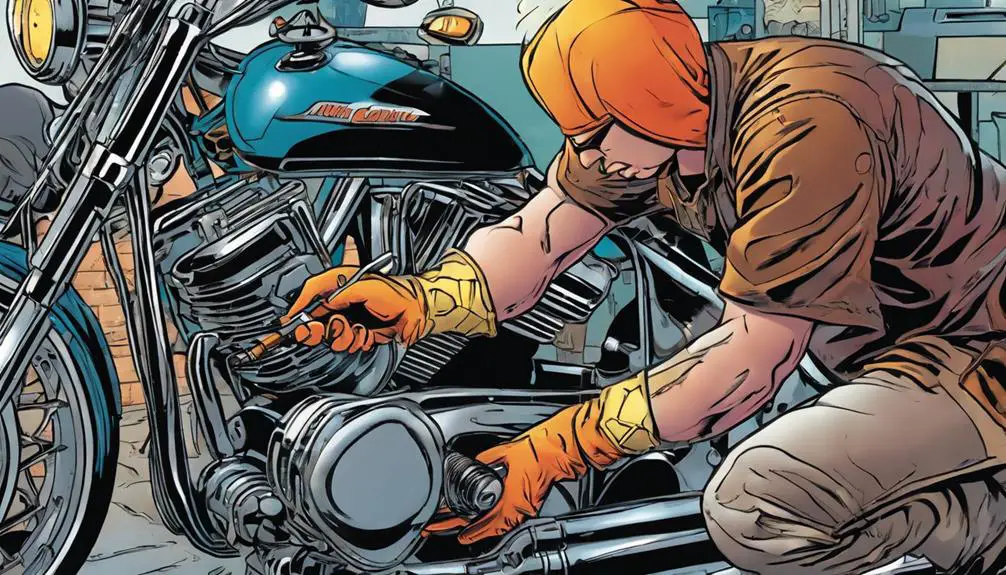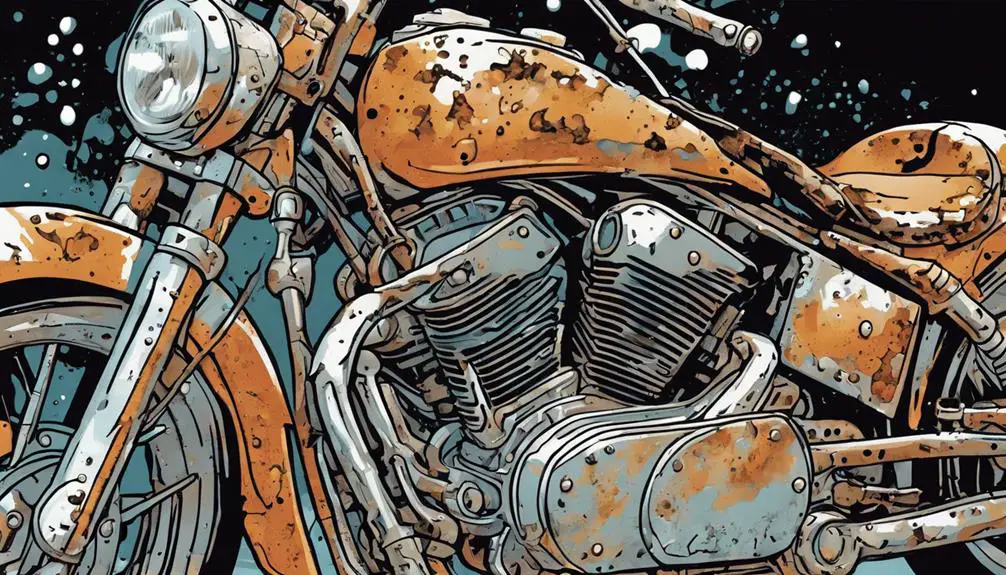You might not realize that the average motorcycle can suffer from corrosion long before it shows visible signs. This slow, often unnoticed deterioration can greatly impact your bike's performance and appearance. By understanding the common areas prone to rust and the environmental factors at play, you can take steps to protect your investment. Maintaining your motorcycle isn't just about oil changes; it's about adopting a thorough approach to care that addresses corrosion head-on. Curious about how you can implement these preventive measures effectively?
Key Takeaways
- Regularly wash your motorcycle with a gentle soap solution to remove dirt, salt, and moisture that contribute to corrosion.
- Inspect metal components frequently for rust spots, flaking paint, or discoloration to identify early signs of corrosion.
- Apply protective coatings like ceramic or rust inhibitors to create a barrier against moisture and contaminants.
- Lubricate moving parts consistently to prevent rust and ensure smooth operation of the motorcycle.
Common Ducati Corrosion Areas

When it comes to Ducati motorcycles, there are several key areas where corrosion tends to be a common issue.
You'll want to pay close attention to the exhaust system, as it's often exposed to heat and moisture. If you neglect it, you can end up with unsightly rust and diminished performance. The swingarm is another critical area; its construction materials can retain moisture, leading to corrosion over time.
Don't forget about the battery terminals and connections. These can corrode quickly, causing electrical issues that can hinder your ride. Also, check the frame, particularly the areas where paint may chip, exposing bare metal to the elements.
You've invested in your Ducati, and you deserve a bike that's not only powerful but also visually stunning. Regular cleaning and maintenance can free your bike from the clutch of corrosion, allowing you to experience true freedom on the road.
Environmental Factors Contributing to Corrosion
Humidity, salt from the ocean, and road de-icing chemicals can all greatly accelerate corrosion on your motorcycle. These environmental factors create a hostile environment for your bike, leading to deterioration that can hinder your freedom on the road.
Consider these key elements contributing to corrosion:
- High Humidity: Moist air can promote rust, especially if your motorcycle's metal parts aren't protected.
- Salt Exposure: If you ride near the coast or through salted roads, the salt can cling to your bike and corrode metal surfaces.
Understanding these factors empowers you to take action. The elements can be relentless, but knowledge is your shield.
By recognizing the risks, you can better prepare and protect your bike, ensuring it stays road-ready. Embrace your ride and the adventures it brings, but remember—staying vigilant against corrosion will keep your motorcycle in prime condition for every journey.
Keep your bike's spirit alive and free, no matter the weather!
Maintenance Tips for Prevention

To effectively prevent corrosion, regularly cleaning and inspecting your motorcycle is vital for maintaining its performance and appearance.
Start by washing your bike with a gentle soap and water solution. This removes dirt, road grime, and salt that can contribute to corrosion. Don't forget to dry it thoroughly afterward, as moisture can linger in hidden areas.
Next, inspect your motorcycle for any signs of wear or damage. Pay close attention to metal components, bolts, and electrical connections. If you spot any rust, address it immediately—use a wire brush or sandpaper to clean it up, then apply a rust-inhibiting primer.
Lubrication is also important. Regularly lubricate your chain and other moving parts to prevent rust and guarantee smooth operation.
Check your seals and gaskets as well; replace them if they show signs of wear.
Protective Coatings and Treatments
Regular maintenance lays the groundwork for protecting your motorcycle, but applying protective coatings and treatments can greatly enhance its defense against corrosion. These coatings act as a barrier against moisture, dirt, and other corrosive elements, giving you the freedom to ride without worry.
Here are three effective options to evaluate:
- Ceramic Coating: This high-tech option provides a durable, hydrophobic layer that repels water and contaminants, making cleaning a breeze.
- Rust Inhibitors: These chemical treatments can be applied to metal surfaces to prevent oxidation and rust formation, extending the life of your components.
Signs of Corrosion to Watch For

Corrosion can sneak up on you, so knowing the key signs to look for is crucial to keep your motorcycle in top shape.
First, pay attention to any rust spots, especially around the frame and metal components. If you see a reddish-brown hue, it's a clear indicator that moisture's been having a party on your bike.
Next, keep an eye out for flaking paint or bubbling. These signs often signal that corrosion is lurking beneath the surface, ready to wreak havoc.
You should also check for any unusual discoloration on metal parts. If your chrome or aluminum starts to look dull or tarnished, that's a warning sign.
Furthermore, listen for any strange sounds or notice any changes in handling. Excessive vibrations or a shaky ride can indicate that corrosion is affecting critical components.
Don't forget to examine bolts and fasteners. If they're loose or showing signs of rust, it's time to take action.
Long-Term Care for Your Ducati
Investing time in the long-term care of your Ducati guarantees it remains a reliable companion on all your rides. To truly enjoy the freedom of the open road, you need to keep your bike in top shape.
Here are three essential care tips:
- Regular Cleaning: Wash your Ducati frequently to remove dirt and grime. Pay special attention to the undercarriage, where moisture can accumulate and promote corrosion.
- Lubrication: Keep all moving parts well-lubricated. This reduces friction and prevents rust, ensuring smooth operation and longevity.
Frequently Asked Questions
How Can I Tell if My Motorcycle's Paint Is Corroded?
To tell if your motorcycle's paint is corroded, start by examining the surface closely.
Look for dullness, discoloration, or flaking paint. If you notice any rough patches or rust underneath the paint, that's a sign of corrosion.
Run your fingers over the surface; any uneven texture can indicate damage.
Don't ignore small spots, as they can lead to bigger issues.
Keeping an eye on these details will help you maintain your ride's beauty.
Are There Specific Cleaning Products I Should Avoid?
When cleaning your motorcycle, you should avoid harsh chemicals like bleach or ammonia-based cleaners. They can strip away protective coatings and harm the paint.
Instead, stick to pH-balanced cleaners designed for vehicles. Don't use abrasive scrubbers or brushes, either; they can scratch the surface.
Always read labels carefully, and trust your instincts—if it seems too harsh, it probably is.
Protect your ride, and it'll reward you with lasting beauty!
Is Rust Repair a DIY Task or Best Left to Professionals?
Rust repair can feel like a dance with destiny—sometimes you lead, sometimes you follow.
If you've got the skills and tools, tackling it yourself can be satisfying. However, if the rust is extensive or the damage threatens structural integrity, it's best to call in the pros.
They've got the expertise to guarantee a thorough job. Ultimately, trust your gut; if you're unsure, don't hesitate to seek professional help for peace of mind.
How Often Should I Inspect My Motorcycle for Corrosion?
You should inspect your motorcycle for corrosion at least once a month, especially if you ride frequently or in harsh conditions.
Pay close attention to areas prone to moisture and dirt buildup.
If you're riding during winter or in salty environments, check even more often.
Catching corrosion early can save you from costly repairs and keep your ride looking great.
Stay proactive, and your motorcycle will thank you for it!
Can I Prevent Corrosion if I Live Near the Ocean?
Living near the ocean can feel like you're walking on eggshells when it comes to corrosion. However, you can definitely take steps to prevent it.
Regularly wash your motorcycle to remove salt and sand, and apply protective coatings or wax to create a barrier.
Keep an eye on vulnerable parts and invest in stainless steel or aluminum components.
Conclusion
By staying vigilant and proactive, you can keep your Ducati looking and performing its best.
Imagine cruising down the road, knowing you've thwarted the threat of corrosion at every turn.
But don't let your guard down—those sneaky spots can creep in when you least expect it.
So, keep up with your maintenance, treat those vulnerable areas, and embrace the ride.
Your motorcycle deserves it, and you won't want to miss the thrill of a well-cared-for machine.